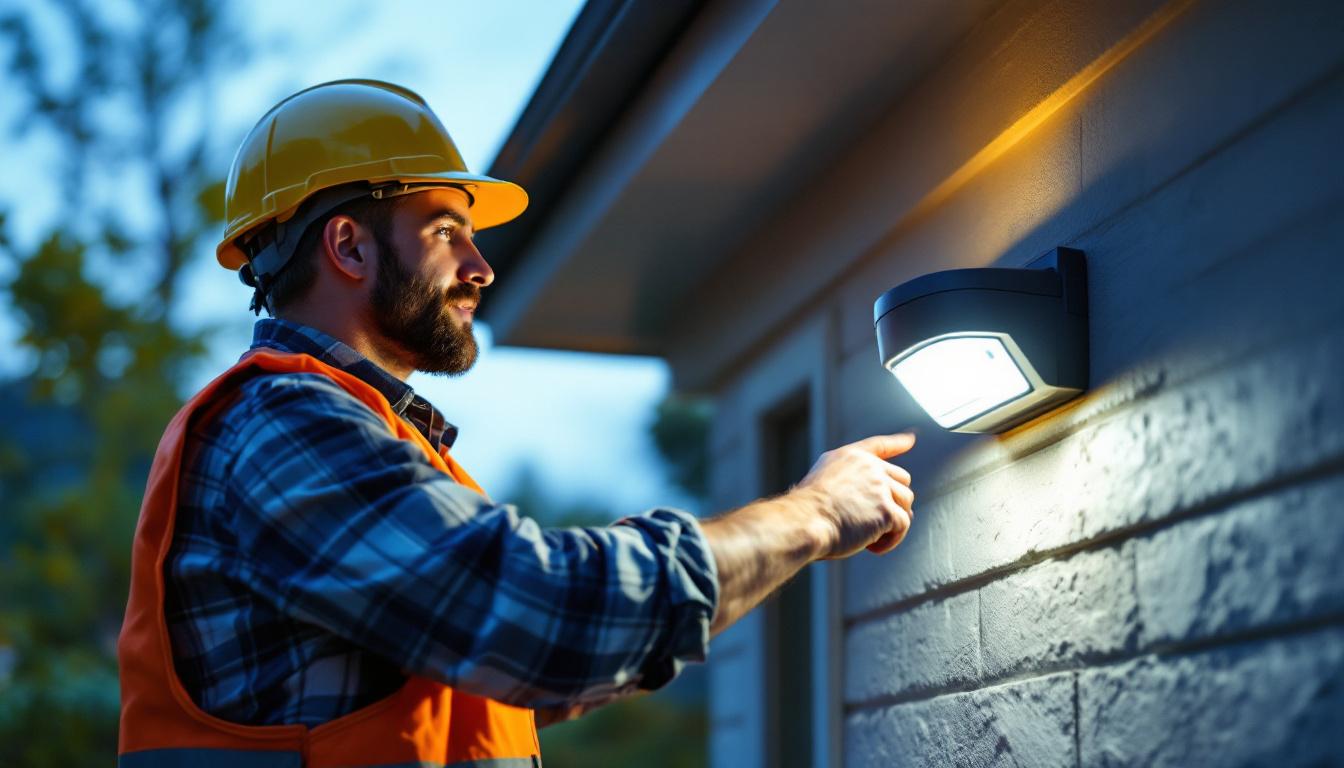
In an era where security is paramount, motion-sensitive security lights have emerged as a vital feature for both residential and commercial properties. For lighting contractors, understanding the nuances of these systems is essential not just for installation but also for maximizing their effectiveness. This article delves into practical tips and insights that can help lighting contractors master the art of motion-sensitive lighting.
Motion-sensitive security lights are designed to detect movement and illuminate areas accordingly. They serve a dual purpose: enhancing security and providing convenience. By understanding how these lights function, contractors can better advise clients on their benefits and applications.
At the core of motion-sensitive lights are sensors that detect movement within a specified range. These sensors can be passive infrared (PIR), microwave, or dual technology, each with its unique advantages. PIR sensors are the most common, using infrared radiation to detect body heat. Microwave sensors, on the other hand, emit microwave pulses and detect changes in the frequency of the reflected waves, making them effective even in adverse weather conditions.
Understanding the operational mechanics of these sensors allows contractors to choose the right type of light for different environments. For instance, PIR sensors may be ideal for residential settings, while microwave sensors might be more suitable for larger commercial spaces. Additionally, certain models come equipped with adjustable sensitivity settings and timers, allowing users to customize their security lighting based on specific needs and preferences. This flexibility can be particularly beneficial in areas where foot traffic varies throughout the day or night, ensuring optimal performance without unnecessary activation.
There are numerous benefits associated with motion-sensitive security lights. Firstly, they enhance safety by illuminating dark areas, deterring potential intruders. Secondly, they contribute to energy efficiency by only activating when movement is detected, reducing unnecessary energy consumption. This feature can be particularly appealing to environmentally conscious clients.
Moreover, these lights can be integrated with smart home systems, allowing for remote control and monitoring. This added convenience can be a significant selling point for contractors looking to provide comprehensive solutions to their clients. Many modern motion-sensitive lights also feature adjustable brightness levels and color temperatures, allowing users to create a welcoming ambiance while maintaining security. Furthermore, some models come with built-in cameras or alarms, adding an extra layer of protection and enabling homeowners to monitor their properties in real-time through mobile applications. This integration of technology not only enhances security but also provides peace of mind, making motion-sensitive lights an attractive option for both residential and commercial properties.
The effectiveness of motion-sensitive security lights greatly depends on their placement. A well-thought-out installation can maximize coverage and minimize false alarms. Lighting contractors should consider several factors when determining the best locations for these lights.
Before installation, it is crucial to analyze the environment where the lights will be placed. Factors such as the layout of the property, existing landscaping, and potential obstructions should be taken into account. For instance, placing lights near bushes or trees may lead to false triggers caused by wildlife.
Contractors should also consider the specific areas that require illumination. Entry points, driveways, and pathways are typically high-priority areas that benefit from motion-sensitive lighting. By focusing on these key locations, contractors can ensure that their clients feel secure and well-lit. Additionally, it is important to assess the proximity of neighboring properties, as lights should be positioned to avoid shining directly into windows or creating disturbances for nearby residents. This careful consideration not only enhances security but also fosters good relationships within the community.
The height and angle at which motion-sensitive lights are installed can significantly impact their performance. Generally, lights should be mounted at a height of 6 to 10 feet to effectively detect motion while minimizing the risk of being tampered with. Additionally, angling the lights downward can help ensure that the sensor is directed toward the area where movement is most likely to occur.
Contractors should also test the sensor’s range and sensitivity during installation. This step is crucial to avoid blind spots and ensure that the lights activate as intended. Adjustments may be necessary based on the specific characteristics of the installation site. Furthermore, it is beneficial to consider the seasonal changes in the environment, such as foliage growth in spring and summer, which can affect visibility and sensor performance. By planning for these variations, contractors can enhance the reliability of the lighting system throughout the year, ensuring that it remains effective regardless of changing conditions.
As technology continues to evolve, so too do the capabilities of motion-sensitive security lights. Lighting contractors should stay informed about the latest advancements to provide clients with the most effective solutions.
Many modern motion-sensitive lights can be integrated with smart home systems, allowing users to control their lighting remotely via smartphone apps. This feature not only enhances convenience but also provides users with real-time alerts when motion is detected. Contractors should highlight these benefits when discussing options with clients, as many homeowners are increasingly interested in smart technology.
Furthermore, some systems offer features like scheduling and dimming, allowing users to customize their lighting based on their preferences. By promoting these advanced functionalities, contractors can position themselves as knowledgeable professionals who understand the latest trends in lighting technology.
With a growing emphasis on sustainability, energy-efficient motion-sensitive lights are becoming more popular. LED options, in particular, offer significant advantages, including longer lifespans and lower energy consumption. Contractors should be well-versed in the various energy-efficient models available and be able to explain their benefits to clients.
In addition to recommending energy-efficient products, contractors can also educate clients about the potential for rebates and incentives related to energy-saving installations. This knowledge can further enhance the value of the contractor’s services and encourage clients to invest in more sustainable options.
Proper installation is critical to the performance of motion-sensitive security lights. Lighting contractors should adhere to best practices to ensure that the systems function as intended and provide maximum security.
When installing motion-sensitive lights, it is essential to ensure that the wiring and power supply are adequate for the system being installed. Contractors should assess the electrical capacity of the property and ensure that the circuit can handle the additional load of the new lights.
Additionally, using weatherproof connectors and fixtures is crucial for outdoor installations. This step helps prevent moisture-related issues that could compromise the functionality of the lights. Ensuring that all wiring is securely fastened and protected from the elements will contribute to the longevity of the installation.
After installation, testing and calibration are vital steps that should not be overlooked. Contractors should take the time to walk through the area to ensure that the lights activate as expected and cover the intended zones. Adjustments may be necessary to fine-tune the sensitivity and range of the sensors.
Encouraging clients to test the system during different times of day and under varying conditions can help identify any potential issues. Providing clients with clear instructions on how to operate and maintain their motion-sensitive lights will enhance their overall experience and satisfaction.
Despite the advantages of motion-sensitive security lights, contractors may encounter challenges during installation and maintenance. Being prepared to address these issues can set a contractor apart from the competition.
One of the most common challenges with motion-sensitive lights is false alarms triggered by non-threatening movements, such as animals or passing vehicles. Contractors should educate clients about the factors that can contribute to false alarms and provide guidance on how to minimize them.
Adjusting the sensitivity settings of the sensors is often the most effective solution. In some cases, relocating the lights or changing the angle of installation can also help reduce false triggers. By proactively addressing these concerns, contractors can enhance the reliability of the systems they install.
Regular maintenance is essential for ensuring the longevity and effectiveness of motion-sensitive security lights. Contractors should advise clients on the importance of keeping the sensors clean and free from obstructions. Dust, dirt, and debris can hinder the performance of the sensors, leading to decreased functionality.
Additionally, contractors can recommend periodic checks of the lights to ensure they are functioning correctly. This proactive approach can help identify any issues early on and prevent more significant problems down the line. Providing clients with a maintenance checklist can be a valuable resource that enhances their overall satisfaction with the installation.
Motion-sensitive security lights are an essential tool for enhancing safety and security in both residential and commercial settings. For lighting contractors, mastering the intricacies of these systems can lead to increased client satisfaction and a stronger reputation in the industry. By understanding how these lights work, choosing the right locations, integrating technology, adhering to installation best practices, and addressing common challenges, contractors can provide exceptional service and solutions to their clients.
As the demand for effective security solutions continues to grow, lighting contractors who invest time in mastering motion-sensitive security lights will be well-positioned to meet the needs of their clients and thrive in a competitive market.
Ready to elevate your lighting projects with the finest motion-sensitive security lights? Look no further than LumenWholesale, where we provide contractors with spec-grade lighting solutions at unbeatable wholesale prices. Our extensive selection is designed to meet the highest industry standards, ensuring you deliver reliable and high-performance lighting to your clients. With free shipping on bulk orders, you can secure premium lighting at the best value — all without hidden fees or compromises. Don’t miss out on the perfect blend of quality, affordability, and convenience. Visit LumenWholesale today and make your next lighting project a shining success.

Discover the ultimate guide for lighting contractors on pole lights LED technology.

Discover essential tips and strategies for lighting contractors to enhance efficiency and project outcomes with Cobra Head lighting.

Discover how UFO LED lamps are revolutionizing the lighting industry and offering lucrative opportunities for contractors.

Discover the transformative impact of portable work lights in modern lighting solutions.